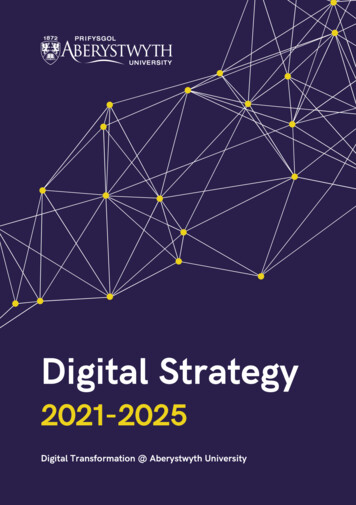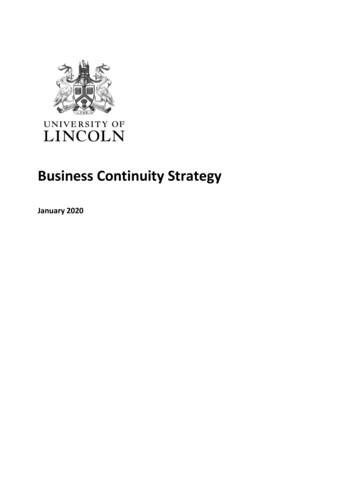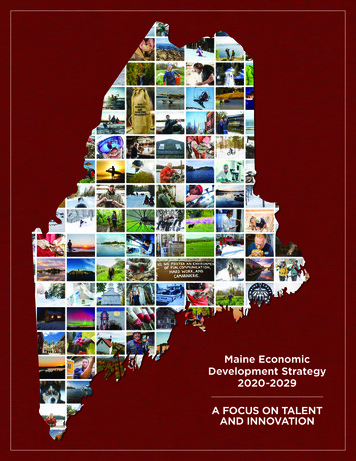
Transcription
Digital Strategy2021-2025Digital Transformation @ Aberystwyth University
0203IntroductionWelcome to Aberystwyth University’s Digital Strategy. The purpose of thisstrategy is to look ahead and set out a vision for adopting a digital approachacross the organisation. Over the period outlined in this strategy, digital willbe core to all the institution’s activities and this document sets out how it willbe used to enhance learning and teaching, research, our administration, andprocesses, as well as our global presence.This strategy has been developed throughconsultation with our students, staff, headsof departments, and the Executive team. Ithas drawn evidence from numerous sourcesincluding the National Student Survey (NSS),Module Evaluation Questionnaires (MEQs),Tell us Now (TUN) comments, InformationServices (IS) User Surveys, and the threeJISC Digital Experience Insights surveys(for teaching staff, professional staff, andstudents). Furthermore, the latest reports andliterature (see references), conferences, andother University digital strategies have helpedformulate it. We expect this strategy to be a“living document”, that will be updated over theperiod considering experience, the changingenvironment and priorities, and levels offunding available. However, the wider themesand principles laid out in this Digital Strategyare likely to remain more constant and help theUniversity navigate a way forward.The Digital Strategy has been fully costed anddetailed action plans developed. Capital andrevenue budgets to support implementationof the Strategy will be submitted as part of theannual planning round process.This document sets out an ambitious vision totransform the University into a sector-leadingdigital organisation. It is supportive of theUniversity’s Strategic Plan 2018-2023, Learningand Teaching (APEX) Strategy 2019-2022, andthe Research and Innovation Strategy 2019-24.The strategy will work with and complementthe University’s Estates and People strategies.This document also reflects the priorities of theWelsh Government’s Digital Strategy for Wales.It is worth noting for clarity what this strategyis not:It is not a strategy for the InformationServices (IS) department; it is a Universitywide strategy that should be ownedacross the organisation.It is not just about computers or IT;people and culture are key to thisstrategy, as is the way we work.It is not just about learning and teaching;it covers all aspects of the University’sbusiness.Digital is a force of disruption, with thebusiness models of entire industries frommusic, publishing, and retail being transformed.The rate of change of the digital revolution isaccelerating. A wave of maturing technologiessuch as artificial intelligence, automation,augmented / virtual reality, Internet of Things(IoT), robotics, data analytics, and mobile / 5Gpresent huge opportunities as well as threatsto Universities. The expectations of current andprospective students around their digitalexperience with the University is also evolvingfast. Aberystwyth University cannot afford tobe complacent; it needs to be technologicallyengaged and move forward on a path of greaterdigital maturity. The overall purpose of thestrategy is to place the University on a strongfooting to respond proactively to wider digitaland societal trends, the rapidly changingtechnological environment, and ultimatelyto be successful in achieving its objectivesthrough digital transformation.Tim Davies, Director of Information Services,June 2021
0405ContextThe Global PandemicWork had begun on this strategy in 2019,however in early 2020 the global COVIDpandemic forced the UK into lock-down. In theUniversity’s case, this involved a rapid shift tostaff working from home and students learningonline. Digital was critical to adapting to thechallenges we all faced. Changes in practiceand adoption of technologies that would havepreviously taken years happened in weeks.This demonstrated that barriers could beovercome, and change implemented quicklywhere there was a need and sense of urgency.The Information Services (IS) department hadto act very quickly and respond to this rapidlychanging situation. In general, more digitallyenabled organisations have fared better in thepandemic. They were better able to meet theneeds of their customers remotely, operate inan online environment, and adapt quickly toexternal events. We need to continue with thisagile and responsive approach as the normand not the exception as we move forwardpost-pandemic. This strategy has been revisedin 2021 in light of the pandemic, which reflectsthe acceleration of already pre-existing digitaltrends; a “digital shift”.Technology TrendsSeveral emerging longer term technologicalthemes are having a growing impact onindustry, the world of work, education, andsociety in general. The term “Industry 4.0”or the “Fourth Industrial Revolution” hasbeen used to describe the impact of thesetechnologies, including: Artificial intelligence Automation Internet of things Big data and analytics Virtual & Augmented reality RoboticsAcceleration of these trends is disrupting entireindustries and business models. HE has beenlargely unimpacted by technological disruption,with digital initiatives mainly seen as peripheral,supportive, and focused on narrow functionalareas. However, “Education 4.0” looks to usethese technologies for learning, teaching,and the wider student experience as well aspreparing students for the world of work inIndustry 4.0. These developments are takingplace against a backdrop of rising expectations,increased competition, cost and fundingpressures, sustainability targets, as well aspotential opportunities for disruption to the HEsector through digitally-enabled new marketsand business models. This strategy will engagethe University with these technologies.
0607Aberystwyth UniversityAt Aberystwyth, digital and information serviceshave played an important role in the overallexcellent student experience at the Universityin recent years. The IT NSS results have beenconsistently high and now (2020) the highestin the UK amongst Universities in the Times& Sunday Times League table (94%). Libraryservices (including information resources)rank third in the UK and top in Wales at 93%.Course specific resources (including equipmentand software) also ranks very high at 93%satisfaction. In an exemplar of “Digitalization”and the potential of digital, technologyplayed a central role in enabling the ModuleEvaluation (MEQ), Tell us Now (TUN) and YourVoice Matters (YVM) quality enhancementprocesses with resultant dramatic increase ofthe University’s NSS satisfaction and leaguetable ratings from 2015 onwards. Learningtechnologies and the student voice initiativesmentioned above were specifically noted in our2018 Gold TEF award and digital was widelymentioned in Times & Sunday Times awards for“University of the Year for Teaching Quality”.Internal surveys (until the November 2020survey during COVID) showed highest levels ofuser satisfaction with IS services since thesurvey began over 15 years ago. In pushingthe digital agenda forward at Aberystwyth,IS has focused on many non-spend meansto achieving these results. These haveincluded a strong focus on the studentvoice and customer service. IS has beenawarded the Customer Service Excellence(CSE) award which benchmarks ISas sector leading in many aspects ofcustomer service.While there are many positives around thecurrent digital landscape at AberystwythUniversity in 2021, there are several challengeswe face:123456A legacy of long-term under-investmentin technology that has only recentlybegan to improve.Partly because of this, an uneveninvestment in digital solutions across theUniversity’s operations, with most focusbeing on learning and teaching.Furthermore, this has resulted in extensiveuse of in-house and on-prem solutionsto fill the gaps that are now obsolete,overly complex, and difficult to maintainand develop. This includes core businesssystems such as the student recordsystem.Historically, a decentralised approachto IT that has meant many digital assetsare not managed centrally with resultantnegative security, reliability, sustainability,and value for money effects.Lack of “ownership” of digital across theinstitution including data and systemsthat relate to roles and functions.While improved by the pandemicrequirements to work remotely, the digitalskills and capabilities of our staff andstudents are very variable, impacting theUniversity’s ability to leverage digital andour students’ employability prospects.
0809Digital MissionThe mission of the Digital Strategy is to“Empower OurPeople throughDigital Technologyand Information”.
1011Digital VisionThe vision is“TransformingAberystwyth Universityinto a Sector-LeadingDigital Organisation”.
1213The strategy consists ofFoundationsThese cross-cutting themes represent the “foundations” of the Digital Strategy (at the bottom ofthe diagram below). These can be seen as pre-requisites and supportive to the pillars ureDigitalWorkplaceEnsure that our staffand students havethe skills, capabilityand confidence to usedigital technologiesat the Universityand in their studies.Students graduatingfrom AberystwythUniversity willhave the digitalskills needed forthe workplace oftomorrow.As an area of highrisk, the University’sCyber Security mustbe prioritised andbe an all-institutionowned issue. A widerange of activitywill be undertakenincluding training,collaboration withexternal bodies,achieving standards,and implementingnew technologies, tomitigate the risks.We will ensure theUniversity has arobust, modern, andwell-maintained ITand communicationsinfrastructure. Keyto our infrastructurestrategy is the “CloudFirst” and “SmartCampus” approaches.This theme will focuson enabling a “HybridWorking” model forstaff. Hybrid willinvolve staff workingsome of the timeremotely and some inthe office.
1415PillarsThese represent specific functional areas for digital development and enhancement. In each ofthese areas we will utilise Digital to increase efficiency, improve quality, support the developmentof new business models, markets and / or funding streams.Deliver anExcellentLearning,Teachingand StudentExperienceSupportResearch andInnovationExcellenceThis strand willfocus on supportingthe delivery of theUniversity’s Learningand Teaching Strategy,2019-2022 “AberystwythPedagogical Excellence(APEX) Strategy” throughdeveloping a “BlendedLearning” framework,review of the mainlearning and teachingtechnologies andpolicies, reviewing thefuture of assessment,and responding to digitalinclusion.This strand of theDigital Strategy willfocus on supportingthe delivery of theUniversity’s Researchand InnovationStrategy 2019-24.This will includeimplementingtechnology tosupport the researchlifecycle and businessengagement,delivering hybridresearch events,responding to theopen science agenda,and reviewing thedelivery of research IT.StreamlineandModernise ourAdministrativeProcessesDigital will be usedacross the Universityto improve theefficiency and qualityof processes. Wewill review, develop,redevelop or replacekey business systems;ensure, where systemsare implemented,they are consistentlyadopted; and takeforward an initiativeon improvingcustomer serviceacross the University.DigitalStrategyEnhanceour DigitalPresenceThis themewill focusingon enhancingthe University’sdigital presencethrough continuedimplementation ofenterprise CustomerRelationshipManagement (CRM),review of the web site,and development ofan Intranet.These foundations and pillars support the overall digital strategy that in turn is supporting thedelivery of the University’s strategic objectives.Deliver anExcellentLearning,Teachingand sesDigital SkillsCyber SecurityDigital InfrastructureDigital WorkplaceEnhanceour DigitalPresence
1617Guiding PrinciplestaSusinableWe should operateconsistently, using simpleand uniform processes,removing bureaucracy, andbreaking down silos. Thiswill involve the focus oninstitution wide as opposedto departmental or teamgoals. There will be higherlevels of cross-organisationalalignment and collaboration.ExcenlleW Supellrtpo eing-bOneUniversityOne University.ipnershBilinguOwalceExcellence.Secu r it yibleAccessThe principles summarized herewill outline the spirit in which thestrategy is approached and willguide all digital initiatives.Digital services should be highquality, innovative, deliveradded value, personalised,and enable users to be moreproductive. Innovation willbe strategic and driven bythe University’s objectives.Effective agile project andchange management willsupport delivery of highquality solutions.i litydouClOwnership.FirstDatone a hassourceerCustomtFirsbpaaCData and systems mustbe clearly owned withinthe organisation. Leadersand managers will bedigitally engaged.Security.Security must be embeddedin the University’s culture andbe everyone’s business.Capability.Our staff and students musthave the skills and confidenceto fully leverage digitalsolutions and information.Customer First.Solutions and services shouldbe built around the customerat the centre. In general, theyshould also be developed inconjunction with the customer.Solutions should be intuitive.Data hasOne source.Data should be integrated,not duplicated. Data qualityis critical to the organisationand will be increasingly usedin informing and adjusting theUniversity’s course.Cloud First.Cloud based delivery willbe selected by default, onlydeveloping internally and /or hosting on premise wherethere is no viable alternativeor where this adds value.Accessible.All services need to beaccessible to all and availablefrom any device, easy to useand navigate.Bilingual.Digital platforms shouldbe available in both Welshand English, supportingthe bilingual nature of theUniversity and Welsh culture.Digital should supportsustainable Welsh-speakingcommunities.Well-being.Digital initiatives shouldconsider the wellbeing ofthose who use the service,as well as promoting equity,diversity, and inclusion.Sustainable.All initiatives should considertheir environmental impactwith the aim of supportinga reduction in resourceconsumption and achievingour net zero target by the endof the 2030-1 financial year.
1819DigitalTransformationDigital TransformationAs outlined in the Vision, this strategy aims to digitally transform theUniversity. The term “digital transformation” is used widely, but what exactlydoes this mean?“Digital Transformation” can be seen as the in the context of other stages: “Digitization”, throughto “Digitalization”, and then to “Digital Transformation”. Digital transformation itself should not beseen as a destination, more of a journey. The terms and examples are explained further below:DigitizationAnalogue to digitalOrganise informationDigitalizationAutomate processesStreamline processesDigitizationDigitization is the process of moving analogueinformation to a digital format. Examples wouldbe handouts, lecture notes and slides beingmade available digitally on the VLE; simpleweb-based forms to capture information;scanning chapters of books and making themavailable; and lectures that are delivered livebut also recorded digitally and made availablefor viewing afterwards.DigitalTransformationStrategicCultural changeCoordinated/organisational wideDigitalizationDigitalization involves transforming individualprocesses and operations. This leverages theopportunities afforded by digital in a specificarea to automate and streamline processes.One example might be digital assessmentsbeing created and submitted, marked andfed back all online. The process includes textmatching for plagiarism detection and newmethods of feedback such as audio or video.Digital Transformation is described byEducause as follows, “In the context ofsweeping social, economic, technological, anddemographic changes, digital transformation(Dx) is a series of deep and coordinated culture,workforce, and technology shifts that enablenew educational and operating models andtransform an institution’s business model,strategic directions, and value proposition.”It involves the strategic and coordinatedorganisation-wide use of technologiesalongside cultural change. An example heremight be the managed adoption of blendedlearning and hybrid working approaches thattransform the estate and deliver our educationto new markets and in new models.Aberystwyth University, and most UK HEIs,is applying Digitization and Digitalization tovarying degrees. Pre-COVID, while there aremany good examples of the application ofdigital, most are not strategic, and the sectorlags behind others in this regard. The vision, asoutlined earlier, is the Digital Transformation ofAberystwyth University.Measures of SuccessThe Digital Strategy covers a wide range of areas of activities and new projects. Manyof these will have their own KPIs to measure their individual success. We recommendthe creation of a Digital Management Group (DMG) that will consider how to assess theeffectiveness of individual projects that are part of the Digital Strategy. At a strategic level,the following indicators will be used to measure success of the strategy:NSS results for questions relating to Digital (Under “Learning Resources”).MEQ “Learning Resources” question results.IS User survey.JISC Digital Insights Survey.
Aberystwyth UniversityAberystwythUKSY23 AberUni/aberystwythuni
the Research and Innovation Strategy 2019-24. The strategy will work with and complement the University's Estates and People strategies. This document also reflects the priorities of the Welsh Government's Digital Strategy for Wales. It is worth noting for clarity what this strategy is not: It is not a strategy for the Information










